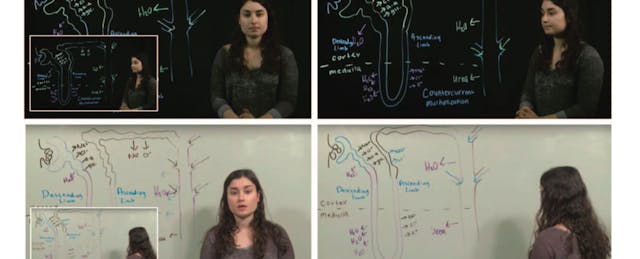As the pandemic has forced more teaching online, plenty of instructors have been trying to figure out the best way to keep students’ attention and interest with lecture videos or Zoom sessions. Meanwhile, learning scientists have been taking a more clinical approach, using experiments to test the question: How important is it for the teacher to be visible on screen?
A series of research projects by researchers at the University of California at Santa Barbara is testing what is known as the “theory of embodied instruction,” which argues that learners look to the instructor’s body for cues on where to focus attention and what is important. The researchers argue that when educators make instructional videos, it’s important for students to be able to see the teacher’s face, and particularly to see their eyes and where they are looking.
When instructors make videos where they use their presence in the video well, the researchers argue in a recent peer-reviewed paper, it can “contribute to greater engagement, promote generative learning, direct efficient integration of the instructional material, and lead to better post-test performance.”
“Multimedia instruction has to include the instructor,” Andrew Stull, one of the authors of the study, recently told EdSurge. “When it’s done well, [teachers are] guiding the learner in how to move through a lesson, optimizing their focus and attention to where it’s supposed to be,” he says. “It’s almost like this symphony that the instructor is the heart of.”
But it turns out that just having a professor’s face on the screen isn’t always a benefit.
That’s what Stull and his colleagues found out in a recent study where they had a professor create four different versions of a 14-minute lecture about human kidney anatomy. For some versions of the video, they used a transparent whiteboard—a high-tech set-up where the professor stands behind a sheet of glass and draws with markers, and the camera reverses the image so that it looks correct to the audience. The idea is that students can always see the instructor’s face, instead of the teacher having to turn away from students to write, and the theory was that the tool would lead to higher student engagement.
“One of the things we do as researchers is we test ideas,” says Stull. “We don’t just assume, or say, ‘that’s cool let’s use it.’”
In one version of the video, the teacher wrote on a conventional whiteboard and never looked at the audience; in another, the teacher wrote on a conventional whiteboard and shifted back and forth between looking at the board and at the audience; in another, the teacher wrote on the transparent whiteboard and always looked at the audience while writing; and in the last, the teacher used a transparent whiteboard but shifted attention between the board and the audience.
While students reported higher engagement when the instructor looked at the camera than when they didn’t, the transparent whiteboard wasn’t always the most effective. Stull says that it seems that actually seeing the teacher’s face the whole time may have distracted attention away from the words and drawings on the transparent whiteboard. “The face is a massive draw—it’s a magnet for attention,” Stull says. “You’ll spend much more time looking at their face, so it probably creates split attention.”
That’s not to say that the transparent whiteboard is ineffective. The finding, Stull says, shows that it’s important for instructors to think carefully about where they are directing their attention during any video lecture, no matter what tools they use.
“It’s a complicated problem,” he says. “It’s important for the instructor to intentionally choreograph the experience and to be aware of how students might be using their body cues to parse and process and engage with the words and the diagrams and the drawings.”
The researchers will be doing more experiments to see how to best apply their theory of embodied instruction in real-world classrooms. They have a saying in their lab that “research is like a pointillist painting,” says Stull. “Each paper is just a dot, and when you have enough dots on the page you start to see what is happening.”


